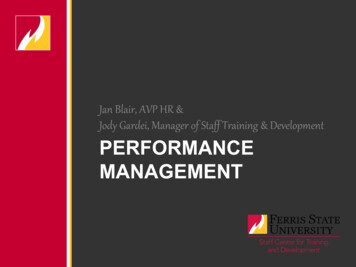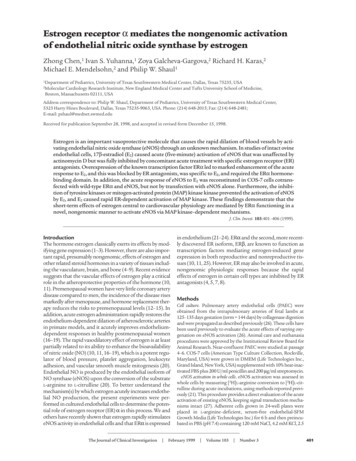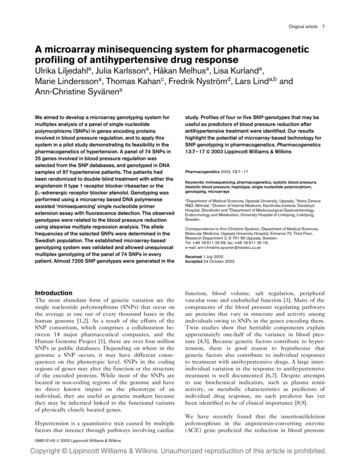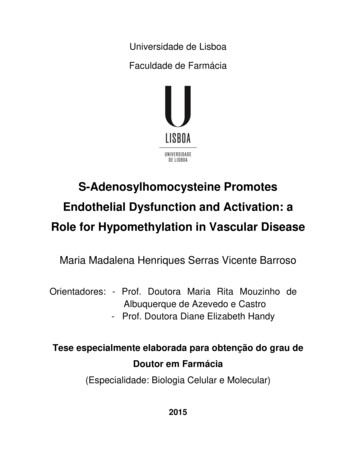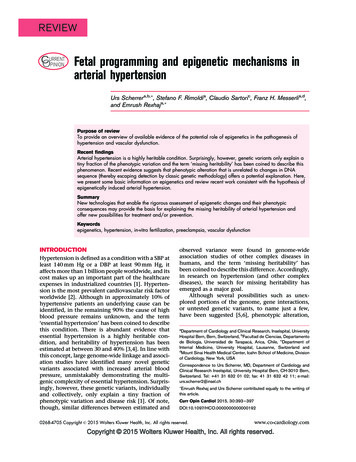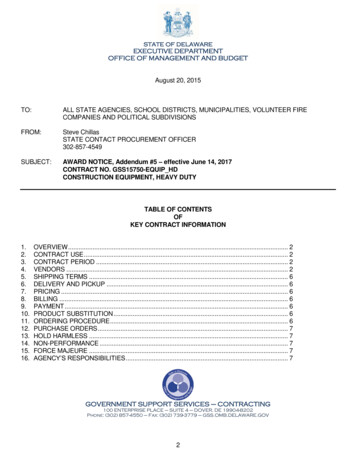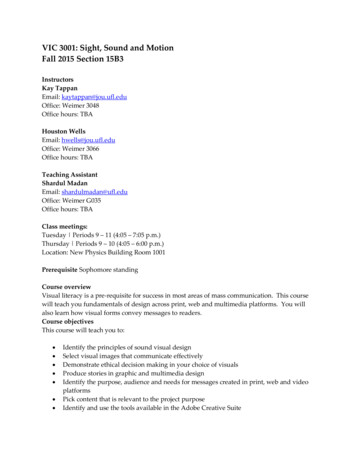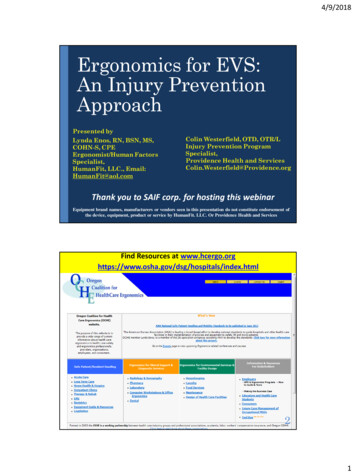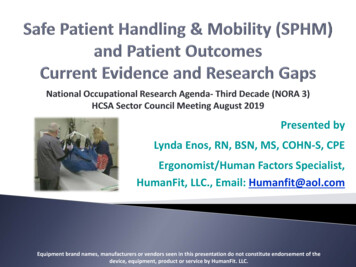
Transcription
Presented byLynda Enos, RN, BSN, MS, COHN-S, CPEErgonomist/Human Factors Specialist,HumanFit, LLC., Email: Humanfit@aol.comEquipment brand names, manufacturers or vendors seen in this presentation do not constitute endorsement of thedevice, equipment, product or service by HumanFit. LLC.
HumanFit, LLC 2013-2019.
Increase risk of: Skin and jointdamage Falls Pain Combativebehaviors Loss of dignity(Nelson, 2006)HumanFit, LLC 2013-2019.
4 What do we know? Missed nursing care Early mobilization and rehabilitation Fall prevention Pressure injury prevention Patient safety and SPHM– other evidencebase outcomesHumanFit, LLC 2013-2019.
5Overall there is very little published research on thelink between SPHM and Patient outcomesData collection and study design challenges: Resources (staff, time, financial etc.) Multiple interventions are implemented at one time Improvements in patient handling for worker and patient safety. McMillan, J., Moo, A.,Newnam, S., & de Silva, A. (2018) & Linking worker health and safety with patient outcomes. Gibson, K., Costa, B., & Sampson,A. (2017). WorkSafe Victoria (WSV). The Institute of Safety, Compensation and RecoveryResearch (ISCRR) Outcomes of Safe Patient Handling and Mobilization Programs: A Meta-Analysis. Teeple et.al (2017). Work, 58(2), 173-184 Safe Patient Handling and Patient Safety: Identifying the current evidence base and gaps inresearch. Enos. L. American Journal of Safe Patient Handling and Movement, 3, (3): 94-102HumanFit, LLC 2013-2019.
6Definition: Any aspect of required patient care that is omitted(either in part or in whole) or delayed by nursing staff.What's being missed? (Kalisch et. Al 2012; Wegmanm, 2011, AHRQ, 2015) AmbulationTurning Patient surveillanceDelayed or missed feedingsPatient educationHumanFit, LLC 2013-2019. Discharge planningEmotional supportHygieneInput and outputdocumentationSurveillanceMissed care or rationing of care associated withhigher likelihood of patient deathThis is a world wide phenomenon in nursing
7Why does it occur? Labor resources available to provide patient careTime to complete taskMaterial resources accessible to assist in patient care activitiesCommunication and various relationship factors that have animpact on nurses’ ability to provide care.(Kalisch et. al. 2009)Consider extra resources needed to care for bariatric,combative, complex/special needs patientsCan SPHM assist to reduce the rate of Missed Nursing Care?No research published to dateHumanFit, LLC 2013-2019.
8 Early mobility definition:Planned movement in a sequential manner beginning at apatient’s current mobility status and returning them tobaseline(Vollman, 2010)Importance of Early Mobility Decreased time on ventilator Decreased length of stay in the ICU and the hospital Mitigates the short-term complications of critical illness:delirium and muscular weakness Mitigates the long-term disabilities of critical illness:physical, cognitive, and psychological Decreased mortality(Hoyer et. al, 2016; Arnold, 2017)HumanFit, LLC 2013-2019.
9Data Little published research Lack of overhead lifts is a barrier to early mobilization(Bassett et al, 2012) Safe patient handling programs and policies and proceduresaround use of mechanical lifting devices can improve patientmobility outcomes by up to 12%.(Gibson et al, 2017)HumanFit, LLC 2013-2019.
10HumanFit, LLC 2013-2019.
11Support from rehabilitation staff is critical Evidence base to support use of SPHM equipment bytherapists: Functional independence measure (FIM) ratingsremained the same or improved when using SPHequipment.(Arnold et. al., 2011; Mcilvane et. al., 2011; Campo M, et. al., 2013) SPH equipment has therapeutic applications inrehabilitation, especially for medically complex orbariatric patients.(Darragh, et. al 2013; Rockefeller, K., 2008)HumanFit, LLC 2013-2019.
700,000 to 1,000,000 people fall in the hospital in US/yearwith 30-35% sustaining an injuryCost: For the Patient Injury/death; Increased length of stay Higher rates of discharge to nursing homes, and loss ofindependence For the Health Care Organization Cost for a serious fall with injury averaging 14,056 perpatient CMS ‘Never Event’HumanFit, LLC 2013-2019.(Fridman, 2019)
13Patient Falls -When do they occur? A majority (80%) of falls are unassisted and occur in thepatient room during evening/over night40% of falls related to toiletingAbout 20% during ambulation(Eileen B Hitcho, 2004)Little data about falls during pivot transfersHumanFit, LLC 2013-2019.
14Challenges: Incomplete or incorrect use of the Risk Assessment ToolLack of quick mobility assessment/check every time a patientis to stand-up/bear weightInconsistent hand-off communication between shifts andunits on fall eventsLower/inadequate staffing levels are associated with higherrate of patient falls Missed nursing care mediates the relationship betweenstaffing levels and patient falls.(Kalisch et. al., 2012)HumanFit, LLC 2013-2019.
15 In the 2013 Agency for Health Care Research andQuality's (AHRQ) Preventing Falls in HospitalsToolkit, Safe patient handling is considered “a criticalelement of universal falls precaution andespecially important for patients who requireassistance with transfers”. Recommend use of clinical pathways that is, theVA SPHM algorithms.Use of ‘user friendly’, standardized, and wellcommunicated, SPHM assessment/mobility checktools to determine correct choice of equipment forsafe mobilization of patientsHumanFit, LLC 2013-2019.
HumanFit, LLC 2013-2019.
17Data: Intermountain Healthcare Salt Lake City, UT After one year of SPH program implementation (2008–2009) Patient falls related to transfer were reduced by 45%. By year-end 2010: 49% reduction in patient falls related to lift and transferactivities.(Joint Commission, 2012) Acute care teaching hospital in rural SC Falls reduced during first year after SPHM programimplementation(Kennedy et al, 2015)HumanFit, LLC 2013-2019.
18 2.5 million patients in U.S. acute-care facilities suffer frompressure ulcer/injuriesCost: For the Patient 60,000 deaths from facility-acquired pressure ulcer complicationsper year Pain and reduced quality of life Increased length of stay Higher re-admittance rate (within 30 days of discharge) For the Health Care Organization Average cost of facility-acquired stage III or IV pressure ulcers: 43,1803 11 billion per year in preventable costs Stage III and IV Pressure Ulcers - CMS ‘Never Event’(Rondinelli, 2018)HumanFit, LLC 2013-2019.
19 Multifaceted and variable by facility Prevention/Management/Treatment - Common themes Assessment Support surfaces that redistribute or alternatepressure Limit linens Turning patients at least every 2 hours Utilizing turn-assist features of the bed Reduce friction and shear Promote early mobility(HRET, 2017)HumanFit, LLC 2013-2019.
20The National Pressure Ulcer Advisory Panel (NPAUP),European PUAP, AHRQ, and Pan Pacific Clinical PracticeGuidelines for Prevention and Management of PressureInjuries state:‘Use lift sheets or lift equipment to reposition or transferpatients and to avoid pulling or dragging, which can causefriction injuries’HumanFit, LLC 2013-2019.
Using equipment to access skin forassessment, wound care and hygieneetc.Use of ceiling lift can promoterepositioning of patient - if sling canstay under patient and often less staffare needed No evidence leaving a sling under apatient will cause skin damage (NPUAP2015) Depends: Patient condition Fabric, design of the sling and fit onpatient Input from Wound Care staffHumanFit, LLC 2013-2019.Ceiling lift use to reduce the needto boost patients in a supineposition
Data: Patient positioning devices and policies and proceduresaround use of mechanical lifting devices can reduce the riskof health-facility acquired pressure injury by up to 17%. (Gibson, K., et. al 2017) 43% decrease in hospital acquired pressure ulcers amongpatients following the implementation of SPHM (Walden et al,2013) 50% decrease in stage III and IV hospital-acquired pressureulcers during the first year after SPHM programimplementation. (Kennedy, 2015)HumanFit, LLC 2013-2019.
23 Decrease in combativeness with use of lifting equipment(Collins et. al, 2006; Pihl-Thingvad, et al, 2018) Patients report feeling more comfortable and secure(Wicker, P., 2000) Increase in physical functioning and activity level, lowerlevels of depression, improved urinary continence, lowerfall risk, and higher levels of alertness during the day.(Nelson et al 2008) Mechanical lifting devices, a suite of ergonomic lift assistdevices and patient positioning devices improve patientcomfort and safety(Gibson et al, 2017)HumanFit, LLC 2013-2019.
24 Positive impact on patient satisfactionPatient satisfaction surveys at Good Shepherd HCS,Hermiston, OR, USA.Conducted Jan 08-Jan 09 inclusive at discharge (SPHMprogram implementation Aug 1, 08)1. Were you lifted/moved with equipment?2. Did you feel safe3. Did you feel comfortable?98% of patients who were lifted/moved withequipment reported it felt safe and comfortable.(Enos, 2011)HumanFit, LLC 2013-2019.
Benefits of a SPHM Program (Operational Gains).for Employees & Patients(Reduced Risk of Falls; Pressure Ulcers & Painetc.; Improved Mobility & Dignity)HealthSafetyComfortSatisfactionWell-being ofEmployees &PatientsHumanFit, LLC 2013-2019.Less absenteeism andlabor turnover.More involvement andcommitment tochange.Adapted from: Corlett, 1995; Nelson 2008;Gallagher, 2009.25.for Health CareOrganizationsImprovedQuality PerformanceEfficiencyFlexibilityRecruitment (LargerLabor Pool) &RetentionReg. ComplianceReduced WC InjuryCosts & LiabilityWell-being oforganization
Nelson, A. L. (2006). Safe patient handling and movement: A practical guide for healthcare professionals. Springer Publishing Company.McMillan, J., Moo, A., Newnam, S., & de Silva, A. (2018) Improvements in patienthandling for worker and patient safety. WorkSafe Victoria (WSV). The Institute of Safety,Compensation and Recovery Research (ISCRR)https://www.iscrr.com.au/ data/assets/pdf file/0004/1321771/EnvironmentalScan tient-safety.pdfGibson, K., Costa, B., & Sampson, A. (2017). Linking worker health and safety withpatient outcomes. WorkSafe Victoria (WSV). The Institute of Safety, Compensation andRecovery Research (ISCRR)http://www.iscrr.com.au/ data/assets/pdf file/0006/1321719/EvidenceReview omes.pdfTeeple, E., Collins, J. E., Shrestha, S., Dennerlein, J. T., Losina, E., & Katz, J. N. (2017).Outcomes of safe patient handling and mobilization programs: A metaanalysis. Work, 58(2), 173-184.Enos, L. (2013). Safe Patient Handling and Patient Safety: Identifying the CurrentEvidence Base and Gaps in Research. Am J SPHM, 3(3), 94-102.HumanFit, LLC 2013-2019.
Kalisch, B. J., & Lee, K. H. (2012). Missed nursing care: Magnet versus non-Magnethospitals. Nursing outlook, 60(5), e32-e39.Wegmann, D. J. (2011). Comparing two identification methods of missed nursingcare (Doctoral dissertation, Texas Woman's University).Missed Nursing Care AHRQ PSNet Patient Safety Primer 2015,http://psnet.ahrq.gov/primer.aspx?primerID 29Kalisch, B. J., & Williams, R. A. (2009). Development and psychometric testing of atool to measure missed nursing care. JONA: The Journal of NursingAdministration, 39(5), 211-219.Vollman, K. M. (2010). Introduction to progressive mobility. Critical care nurse, 30(2),S3-S5.Hoyer, E. H., Friedman, M., Lavezza, A., Wagner‐Kosmakos, K., Lewis‐Cherry, R.,Skolnik, J. L., . & Needham, D. M. (2016). Promoting mobility and reducing length ofstay in hospitalized general medicine patients: A quality‐improvement project. Journalof hospital medicine, 11(5), 341-347.Arnold, M. (2017). Building a Foundation of Mobility: From the ICU and Across theHumanFit, LLC Continuum2013-2019of Care, Int J SPHM, 7 (1), 40-44. .
Schubert, M., Clarke, S. P., Aiken, L. H., & De Geest, S. (2012). Associations betweenrationing of nursing care and inpatient mortality in Swiss hospitals. InternationalJournal for Quality in Health Care, 24(3), 230-238.Bassett, R. D., Vollman, K. M., Brandwene, L., & Murray, T. (2012). Integrating amultidisciplinary mobility programme into intensive care practice (IMMPTP): amulticentre collaborative. Intensive and Critical Care Nursing, 28(2), 88-97.Arnold, M., Radawiec, S., Campo, M., & Wright, L. R. (2011). Changes in functionalindependence measure ratings associated with a safe patient handling andmovement program. Rehabilitation Nursing, 36(4), 138-144.Mcilvane et al. (2011). Integrating patient handling equipment into physical therapyactivities in a rehabilitation setting a case series. AJSPHM, 1(3), 16-22.Campo, M., Shiyko, M. P., Margulis, H., & Darragh, A. R. (2013). Effect of a safepatient handling program on rehabilitation outcomes. Archives of Physical Medicineand Rehabilitation, 94(1), 17-22.Darragh, A. R., Campo, M. A., Frost, L., Miller, M., Pentico, M., & Margulis, H. (2013).Safe-patient-handling equipment in therapy practice: Implications forrehabilitation. American Journal of Occupational Therapy, 67(1), 45-53.HumanFit, LLC 2013-2019.
Rockefeller K. (2008). Using technology to promote safe patient handling andrehabilitation. Rehabilitation Nursing, 33(1):5-11.Fridman, V. (2019). Redesigning a Fall Prevention Program in Acute Care: Buildingon Evidence. Clinics in geriatric medicine, 35(2), 265-271.Hitcho, E. B., Krauss, M. J., Birge, S., Claiborne Dunagan, W., Fischer, I., Johnson, S.,. & Fraser, V. J. (2004). Characteristics and circumstances of falls in a hospitalsetting: a prospective analysis. Journal of general internal medicine, 19(7), 732-739.Kalisch, B. J., Tschannen, D., & Lee, K. H. (2012). Missed nursing care, staffing,and patient falls. Journal of nursing care quality, 27(1), 6-12.Preventing Falls in Hospitals A Toolkit for Improving Quality of Care. AHRQPublication No. 13-0015-EF 2013 Agency for Healthcare Research and Quality,Rockville, ital/fallpxtoolkit/index.htmlJoint Commission. (2012). Improving patient and worker safety: opportunities forsynergy, collaboration and innovation. Oakbrook Terrace, IL: The JointCommission, 171. nFit, LLC ImprovingPatientAndWorkerSafety-Monograph.pdf 2013-2019 .
Kennedy, B., & Kopp, T. (2015). Safe patient handling protects employees tooNursing2018, 45(8), 65-67.Rondinelli, J., Zuniga, S., Kipnis, P., Kawar, L. N., Liu, V., & Escobar, G. J. (2018).Hospital-acquired pressure injury: Risk-adjusted comparisons in an integratedhealthcare delivery system. Nursing research, 67(1), 16.Walden, C. M., Bankard, S. B., Cayer, B., Floyd, W. B., Garrison, H. G., Hickey, T., .& Pories, W. J. (2013). Mobilization of the obese patient and prevention ofinjury. Annals of surgery, 258(4), 646-651.Brienza, D., Deppisch, M., Gillespie, C., Goldberg, M., Gruccio, P., Jordan, R., . &Thurman, K. (2015). Do Lift Slings Significantly Change the Efficacy of TherapeuticSupport Surfaces? A National Pressure Ulcer Advisory Panel White venting Pressure Ulcers in Hospitals: A Toolkit for Improving Quality of Care.AHRQ. 2011. it/index.htmlHumanFit, LLC 2013-2019.
Health Research & Educational Trust (2017, April). Hospital Acquired PressureUlcers/Injuries (HAPU/I): 2017. Chicago, IL: Health Research & Educational Trust.http://www.hret-hiin.org/Australian Wound Management Association. (2012). Pan Pacific clinical practiceguideline for the prevention and management of pressure injury. Osborne Park, WA:Cambridge Media, 1-124.European Pressure Ulcer Advisory Panel (2014). NPUAP-EPUAP-PPPIA Pressure Ulcertreatment & Prevention 2014 Quick Reference Guide qrgWicker, P. (2000). Manual Handling: In the Perioperative Environment. British Journalof Perioperative Nursing (United Kingdom), 10(5), 255-259.Collins JW, Nelson A, and Sublet (2006). Safe lifting and movement of nursing homeresidents. DHHS (NIOSH) Publication No. 2006-117. Cincinnati, OH: National Institutefor Occupational Safety and Health. ad, J., Brandt, L. P., & Andersen, L. L. (2018). Consistent use of assistivedevices for patient transfer is associated with less patient-initiated violence: crosssectional study among health care workers at general hospitals. Workplace health &safety, 66(9), 453-461.HumanFit, LLC 2013-2019.
Kjellberg, K., Lagerström, M., & Hagberg, M. (2004). Patient safety and comfortduring transfers in relation to nurses’ work technique. Journal of advancednursing, 47(3), 251-259.Nelson, A., Collins, J., Siddharthan, K., Matz, M., & Waters, T. (2008). Linkbetween safe patient handling and patient outcomes in long‐term care.Rehabilitation Nursing, 33(1), 33-43.Enos L, & Hess, J. (2011) Implementing a Sustainable Safe Patient/PatientHandling Program: The Oregon Facility of Choice Program. Presentation at theGovernor's Safety and Health conference, Portland OregonPhotos courtesy of Oregon Health and Science University (OHSU) Hospital,Portland, OR and Alphamodalities, WAHumanFit, LLC 2013-2019.
Presented by . Lynda Enos, RN, BSN, MS, COHN -S, CPE. Ergonomist/Human Factors Specialist, HumanFit, LLC., Email: Humanfit@aol.com. Equipment brand names, manufacturers or vendors seen in this presentation do not constitute endorsement of the
